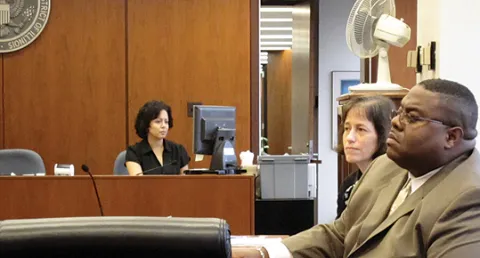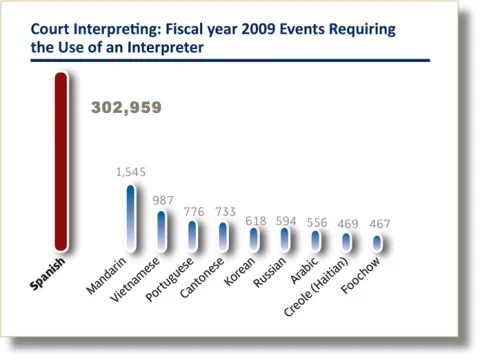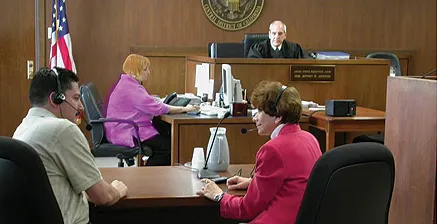
Financial management systems and procedures were refined during the year through technology advances and training.
Budget Management Tools
As part of the fiscal year 2009 financial plan, courts were provided additional budget management tools. The Capital Investment Fund is a new initiative, which allows local court units to deposit and carry forward funds for specific capital investments such as tenant alterations, cyclical facilities maintenance, and courtroom technology. The Budget and Finance Advisory Council suggested the fund as a tool to help courts realize savings. The Judicial Conference and Congress approved the fund as a pilot program through fiscal year 2012. More than 200 court units deposited nearly $10 million into the Fund during fiscal year 2009.
Another new tool provided to the courts was a formula-based direct allotment for tenant alterations. This new formula provides a predictable stream of resources to the courts for tenant alterations instead of requiring the courts to fund these needs through reprogramming, as before. Court and AO input to the Budget Committee led to Judicial Conference and Congressional approval of a portion of the direct allotment, about $6 million, as part of the fiscal year 2009 financial plan. Full implementation will occur in the FY 2010 financial plan.
Financial Management
A study is nearing completion to identify the best technical solution for consolidating the financial management system, FAS4T, used in the courts with the latest version already in use at the Administrative Office. In addition, follow-on work will identify the business process changes and impacts brought about by this software upgrade.
Civil Criminal Accounting and Cash Receipting
The AO continues to implement the Civil Criminal Accounting Module of the financial management system (CCAM). This system is now used by 76 courts to perform civil and criminal accounting and cash receipting functions. In FY 2008, the implementation strategy began to place more emphasis on data reconciliation and checkpoints for monitoring each court’s readiness before moving to the operational state. CCAM is expected to be fully operational in all courts in early fiscal year 2011.
Criminal Justice Act Panel Attorney Payment System Upgrade
The AO is finalizing implementation plans for upgrading the Criminal Justice Act (CJA) payment system to a web-based application to be hosted at the Judiciary’s data service facility. The CJA payment system is used by courts to pay panel attorneys who represent individuals charged with federal crimes but who cannot pay for their legal defense. The upgrade modernizes the system’s platform to improve reliability, performance, and reporting. Implementation is scheduled to be completed by late FY 2010.
Guide Redesign Project
The Administrative Office is revising its primary policy document for federal courts, the Guide to Judiciary Policies and Procedures (Guide). The redesign effort seeks to improve the clarity, accuracy, and timely delivery of the guidance. In March 2009, the Director created a Guide Redesign Editorial Review Board to shepherd the project and design an effective long-term system to keep the Guide updated. At the Board’s recommendation, the publication has been renamed the Guide to Judiciary Policy and refocused to encompass all Judiciary administrative policies promulgated by the Judicial Conference and the Director. The redesign of the Guide is scheduled to be completed in 2010.
Automated Court Reporter Application

Staff court reporters now file their quarterly activity reports and yearly earnings reports online using the Automated Court Reporter Application that cuts paperwork and mailings.
In March of fiscal year 2009, the AO announced the availability of the Automated Court Reporter Application (ACRA) for use by Federal Official Court Reporters. ACRA is a web-based application that automates the submission of the attendance and transcripts forms and the statement of earnings forms. ACRA has been used to capture the data reported on these forms, beginning in calendar year 2009, and incorporates digital signatures as an official approval, using the industry standard of Public Key Infrastructure digital certificates. As of October 2009, ACRA start-up instructions have been provided to 68 of the 94 district courts for nearly 600 of the approximately 733 court reporters and 94 court officials.
District Methods Analysis Program
Court administration staff, as part of the District Methods Analysis Program, worked with the judges program staff, and the Judicial Panel on Multi-District Litigation to establish a working group to address best practices for the management of multi-district litigation (MDL) cases in the district courts. Comprising subject matter experts, the court staff volunteers “map” MDL case processing in their respective offices. The group met in September 2009 to discuss and develop best practices for managing MDL cases as transferee and transferor courts. The group will post best practices for reference and use by court colleagues on the Judiciary’s intranet site.
Central Violations Bureau
The Central Violations Bureau (CVB) provides participating U.S. district courts and federal law enforcement agencies with an efficient processing system for handling petty offenses and some misdemeanor cases initiated by a violation notice.
During fiscal year 2009, the CVB processed more than 350,000 citations and collected approximately $21 million in fines and forfeitures, which have been deposited in the Crime Victims Fund. In addition, approximately $5.7 million was collected through a $25 processing fee, and those funds were used to support Judiciary operations. The CVB also fielded approximately a half-million telephone calls and emails from the public, courts, and law enforcement agencies.
Court Interpreting

In fiscal year 2009, there was an 11.0 percent increase in the number of events requiring the use of interpreters in the courts. District courts reported that they used interpreters in 313,969 events, compared to 282,733 events reported in fiscal year 2008. The number of languages requiring interpretation increased from 113 in 2008 to 120 in 2009.
Interpreter Certification
In fiscal year 2009, a record 473 candidates took the oral examination component of the Spanish/English Federal Court Interpreter Certification Examination, and 85 candidates passed the exam and received certification. The written examination was offered in August 2008 in 33 locations nationwide, and will be offered again in fiscal year 2010. Those who pass the written examination are eligible to take the oral examination, which will be offered in fiscal year 2011.
National Court Interpreter Database
The web-based National Court Interpreter Database (NCID) contains the names of 968 active certified interpreters and 3,155 otherwise qualified interpreters in 145 languages. The number of otherwise qualified interpreters listed in the NCID grew by 475 in fiscal year 2009.
Telephone Interpreting

High qualification standards, including the stringent Spanish/English Federal Court Interpreter Certification Examination, contribute to the critical role that interpreters play in federal court proceedings.
The Judiciary’s Telephone Interpreting Program (TIP) provides remote interpretation in short proceedings where certified or otherwise qualified court interpreters are not locally available. The TIP saved an estimated $1.1 million in interpreter travel and contract costs in fiscal year 2009, and $7.8 million over the life of the program. More importantly, TIP ensured that qualified interpreters were available for defendants in court proceedings. In fiscal year 2009, the Judiciary’s TIP services were used in more than 3,740 events in 43 languages, with Spanish used for 92 percent of TIP events. In total, 47 district courts used TIP services.
The eight provider courts this year were: the Central District of California; District of New Mexico; Northern District of Illinois; Southern District of Florida; District of Columbia; Southern District of California; District of Nebraska; and the District of Rhode Island. Staff interpreters handled 75 percent of TIP proceedings. The other 25 percent of the proceedings were handled by contract interpreters.
Bankruptcy Forms Modernization
The Forms Subcommittee of the Advisory Committee on Bankruptcy Rules, with AO staff support, has undertaken a multi-year Forms Modernization Project to develop recommendations for making the bankruptcy forms more user-friendly to reduce errors, and to take better advantage of technology. The Project has elicited comments from judges, clerks, and other participants in the bankruptcy system, and representatives from a number of groups within the Judiciary have shared their specialized expertise.
A subgroup is evaluating new technologies to allow clerks and judges easier access to data contained in bankruptcy forms, as well as better preparation of customized reports, and increased search capabilities. The process of reformatting and rephrasing the hundreds of questions on the forms also is underway.
The Project continues to solicit feedback from users of the forms through a series of questionnaires, and has also provided to the Next Generation CM/ECF project a list of functional requirements. Using feedback, the Advisory Committee developed an amended reaffirmation forms package to make it easier for debtors and creditors to understand and complete it with fewer errors. The revisions should also make the form easier for the courts to review. The reaffirmation package has been issued by the Administrative Office, effective December 1, 2009.
Bankruptcy Noticing Contract
The new performance-based bankruptcy noticing contract the Administrative Office awarded to BAE Systems Information Technology, Inc. took effect on October 1, 2008. The transition to the new contract was an overwhelming success, largely due to the many contributions made by the bankruptcy court community.
Building on past success, new value-added features and solutions are increasing efficiencies and providing additional cost savings to the Judiciary. A very practical cost-saving improvement began in February 2009 with the elimination of duplicate notices to joint debtors at the same address by sending a single copy of each notice in a jointly-addressed envelope. This improvement in joint cases—approximately 30 percent of cases nationally—is anticipated to provide savings of over $500,000 each year, while providing better service to joint debtors by reducing the number of duplicate notices they must handle.
The new contract provides more services at pricing approximately 36 percent below the former contract rates. Assuming a 10 percent annual increase in BNC program usage, the Judiciary will realize a 10-year reduction of over $50 million compared to the previous rates. This is in addition to the approximately $70 million saved since 1994 for combined salaries, supplies, postage, and equipment savings over court-based noticing. Implementation of the new BNC contract is an excellent example of collaborative efforts involving AO staff and court personnel.
Annual Report 2009
- Annual Report 2009
- Legislative Activity
- Direct Impact On The Public
- Judges Programs
- Facilities, Security, and Emergency Planning
- Business Improvements, Studies, and Activities
- Key Studies and Activities
- Human Resources
- Technology
- Probation and Pretrial Services
- Defender Services
- Communications
- In Profile
- A Strategic Direction For The Administrative Office of the United States Courts, Fiscal Years 2009–2013
